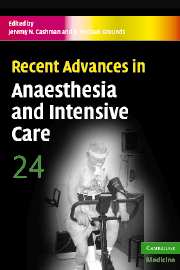Book contents
- Frontmatter
- Contents
- List of contributors
- Preface
- 1 The role of cardiopulmonary exercise testing in preoperative evaluation of surgical patients
- 2 Oesophagectomy for cancer
- 3 Vascular surgery
- 4 Anaesthesia for the elderly
- 5 Deaths following anaesthesia: lessons from NCEPOD
- 6 Pelvic and acetabular trauma
- 7 Echocardiography
- 8 Levosimendan
- 9 Critical care outreach: 6 years on
- 10 Critical care and biological disasters: lessons learned from SARS and pandemic influenza planning
- 11 Evaluating clinical performance
- 12 Non-technical skills and anaesthesia
- 13 Simulators in anaesthetic training to enhance patient safety
- Index
- References
13 - Simulators in anaesthetic training to enhance patient safety
Published online by Cambridge University Press: 15 December 2009
- Frontmatter
- Contents
- List of contributors
- Preface
- 1 The role of cardiopulmonary exercise testing in preoperative evaluation of surgical patients
- 2 Oesophagectomy for cancer
- 3 Vascular surgery
- 4 Anaesthesia for the elderly
- 5 Deaths following anaesthesia: lessons from NCEPOD
- 6 Pelvic and acetabular trauma
- 7 Echocardiography
- 8 Levosimendan
- 9 Critical care outreach: 6 years on
- 10 Critical care and biological disasters: lessons learned from SARS and pandemic influenza planning
- 11 Evaluating clinical performance
- 12 Non-technical skills and anaesthesia
- 13 Simulators in anaesthetic training to enhance patient safety
- Index
- References
Summary
Simulation is revolutionising the education and training of anaesthetists all over the world and is a significant contributor to enhancing patient safety. Anaesthesiology is once again emphasising its role as a pioneering discipline for increasing patient safety. Different forms of simulators are available in many countries and new types of simulators are being further developed. Recently the field has also advanced in conceptual terms with new and creative ideas for using these advanced technical tools. Simulators are used in educational settings, for research, and for assessment. The traditional centre-based simulations are now supplemented by mobile ‘in situ’ simulation training, bringing simulation to work places. New instructors can choose from a variety of courses and other resources for learning the craft and the art of conducting simulations.
The introduction of simulation, especially with video-based debriefing, contributed considerably to the discussing of human factor theories in the medical domain. In anaesthesia this process was pioneered by Cooper and the group led by Gaba and Howard with their concept of crisis resource management (CRM (c.f. crew resource management, Ch. 12)). The CRM-based simulation course model made its way around the globe. Simulation worked as a very powerful tool to make healthcare professionals aware of the impact of human error and how to deal with human limitations, and how best to use unique human capabilities in order to reduce errors, detect problems early and to take effective teamwork countermeasures to ensure patient safety.
- Type
- Chapter
- Information
- Recent Advances in Anaesthesia and Intensive Care , pp. 213 - 232Publisher: Cambridge University PressPrint publication year: 2007
References
- 3
- Cited by

